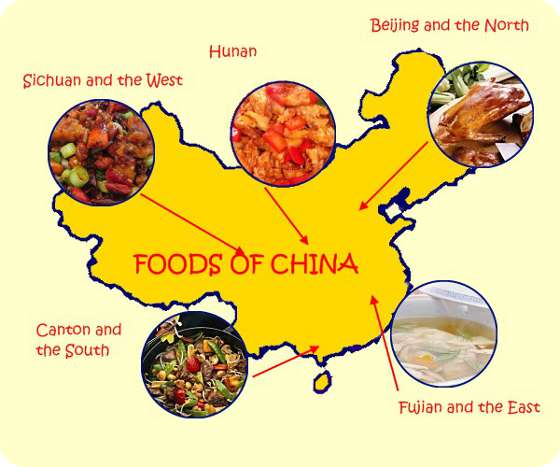Shanghai: The Eastern Cuisine
As you follow the Yangtse River eastward out of the Szechuan region, you will arrive into eastern China, which lies on a great plain formed by the Yangtze River and ends with its river delta. The river delta encompasses some of the most fertile land in China, and flows into the sea just north of the famous city of Shanghai . The Yangtse River region in eastern China experiences a temperate climate with warm springs, hot summers, cool autumns, and relatively cold winters. It is the greatest rice-producing region in China , and you will find a plethora of creative ways that the regional cuisines use to incorporate rice into the dishes.

Rice wine is used extensively as seasoning and marinade. Rice is often used as a stuffing, or to make classic dishes such as Eight Treasure Rice Pudding - a deliciously sweet steamed pudding dessert . Lotus leaves are frequently used as wrapping material for steaming fish, meat, and rice. Paper-wrapped and cellophane-wrapped dishes are very common in the region, as well.
The eastern Chinese cuisine is basically divided by the Yangtse River into Kiangsu to the north, Chekiang to the south, and Shanghai in the delta region.
Shanghai is the largest city in China. It has been the center of China's trade and industry for centuries. Some argue that Shanghai does not have a cuisine of its own, being the "melting pot" of the region, while others argue that exact reason is why Shanghai cuisine should represent the eastern Chinese cuisine. Regardless, it does have its own distinctive local dishes called benbang cai. Benbang cai is noted for its use of red-cooking, with dark soy sauce, and its abundant use of sugar. All of which produces rich, sweet dishes with exquisite flavors and appearance.
The Chekiang and Kiangsu are known as the land of rice and fish, and is one of the wealthiest and most heavily populated regions of China. Their cuisines feature a broad variety of fish and aquatics, such as carp, clam, mullet, perch, and prawns. Minced chicken and bean-curd slivers are also specialties of these provinces. Foods are often arranged in attractive floral patterns prior to serving.
The Chekiang province is well-irrigated by the Yangtse River, criss-crossed with countless complex system of lakes, marshes, ponds, lakes, and multiple river channels, ideal for ducks, fish, frogs and eels. Chekiang cuisine is known to be the least greasy of the three, and well-regarded for its light, fresh, tender, soft dishes, with smooth, but rich fragrance. The dishes are also the least greasy of the three. Duck, freshwater fish, and shellfish dishes are the specialties.
Kiangsu Cuisine, most likely has the longest history in the region. Numerous regional specialty dishes are know to be centuries old. Fish and rice are the main ingredients, and the freshness of ingredients is extremely important, as many dishes require them to be cooked alive and quickly to retain the tenderness and its natural sweetness. Vegetables are often cooked with the fish in the same pot to preserve its freshness. Cooking techniques consist of stewing, braising, and roasting. The dishes in general are sweeter and greasier.
In the final part of the 4 part series, we will cover Canton and Fukien: the southern cuisine.
Editor's Note: Helen Fan grew up in a family that has owned various Asian restaurants all over North America, from Vancouver (Canada), Houston (Texas), Decatur (Illinois), to Chicago (Illinois). She, and the rest of the Fan family are now sharing their decades of knowledge on the art of Chinese cuisine at Chinese Home Cooking.
